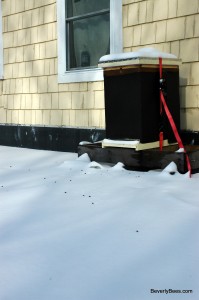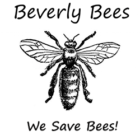What does a beekeeper do with bees in January and February?
Are there jobs to do when the bees are tucked away in the hive all day? What are the bees doing in there anyway?
Beekeeping is a local art, similar to a plant hardiness zone and completely dependent on the climate where the hives reside. Just as every growing season is not the same, every beekeeping season is also different. The plant hardiness zone here in Essex County, MA is 6b. In January and February it is cold, with average temperatures ranging from 16 to 39 degrees F, and the ground is usually covered in snow and ice. Depending on your local climate, how close to average the season is progressing, and what your bees are doing, the following activities may differ for you.

At this time in Massachusetts, it is often too cold for honeybees to fly. There is no consistent source of pollen or nectar for them to eat. Honey bees do not hibernate, they remain active inside the hive, leaving only briefly on an unusually warm day.
The male drone bees have long been gone and the hive consists solely of female bees and their queen. So what are all these girls doing now? The workers have gathered together in a ball in the brood chamber forming a cluster around the queen. The female bees shiver their wing muscles by expanding and contracting them. This generates enough heat to bring the internal temperature of the cluster anywhere from 57-85 degrees F to keep the colony from freezing, or even all the way up to 93 degrees F if they are raising new brood. As the outside temperature rises and falls the cluster size will shrink or grow to adjust.
At this time, they are eating their stored honey. To access it the cluster moves around the hive together as a group when the temperature rises above 40 degrees F. If the temperature gets warm enough, they are able to break cluster to move to a new area of honey or break apart and form smaller clusters, rejoining the larger cluster as needed. Sometimes a smaller cluster will get isolated from the larger one due to unexpected temperature swings and these smaller groups of bees can die.
The location of the large cluster tends to start in the bottom brood chamber and move up as the temperature cools and the stores below are depleted. Over the winter months, bees may consume 80 to 120 lbs of honey (all beekeeping is local so this varies greatly depending on your area). They may also be raising a small amount of brood. All this activity creates water vapor in the hive so adequate ventilation is needed in the winter as much as in the summer. A wet bee cluster can mean death for a hive.
If the bees are lucky and the temperature warms enough, they may be able to take a cleansing flight. If they are unlucky, the bees will need to hold their feces until the temperature gets warm enough for them to leave the hive. If the temperature is too cold for too long and the bees cannot leave, they may develop dysentery inside the hive.
So you see, even in the winter the beekeeper has a lot to think about, unfortunately there is not much for them to do.
Here are some tasks a beekeeper can do.
- Keep the hive entrance clear of snow and debris to allow for proper hive ventilation.
- As soon as the temperature rises to 50 degrees, preferably in January, take a quick peek inside the hive. Without removing any frames, see if you can spot the location of the cluster. How are they doing for food stores? It is a good idea at this time to provide your bees with fondant, sugar candy or granulated sugar to ensure they have enough food. You can also install a candy board with a pollen patty hidden inside it. Read how to make and install a candy board here.
- If the temperature is too cold to open the hive, you can listen to the hive instead. Do you hear the gentle hum of the cluster? If so, you can be relieved to know your bees are still alive. Wait for a warmer day to open the hive and take a look at them. If you are accustomed to knowing the weight of your hive full of honey, you can also lift the hive slightly to judge how much food stores the bees have left. This will give you an idea how soon they will need supplemental food.
- Assess your equipment and plan for the upcoming year. Now is the time to order new equipment, build, paint, clean and repair if needed.
- Order new package bees and/or queens to be delivered in the spring. In this area we start package bees in mid April to early May.
- Attend local bee club meetings, take or register for a beekeeping class, read beekeeping books and articles, but most importantly relax, you have a big season ahead of you.
